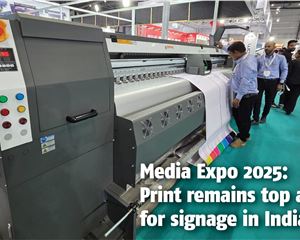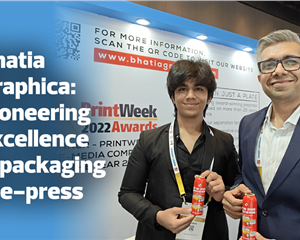Kiran Prayagi, print technologist and chairman, Graphic Art Technology & Education demystifies colour management in a series of articles. In this fifteenth and sixteenth article, he discussed glossary in colour management.
From now onwards advance study on ‘colour management’ will begin, therefore, it is
important familiarise oneself with the colour terminology. This issue and next issue will carry
the ‘colour terms’ before beginning advance study.
Absorb / Absorption: Dissipation of the energy of electromagnetic waves into other forms as
a result of its interaction with matter; a decrease in directional transmittance of incident
radiation, resulting in a modification or conversion of the absorbed energy.
Additive Primaries: Red, green, and blue light. When all three additive primaries are
combined at 100% intensity, white light is produced. When these three are combined at
varying intensities, a gamut of different colours is produced. Combining two primaries at
100% produces a subtractive primary, either cyan, magenta, or yellow: 100% red + 100%
green = yellow; 100% red + 100% blue = magenta; 100% green + 100% blue = cyan. See
Subtractive Primaries.
Appearance: Manifestation of the nature of objects and materials through visual attributes
such as size, shape, colour, texture, glossiness, transparency, opacity, etc.
Attribute: Distinguishing characteristic of a sensation, perception or mode of appearance.
Colours are often described by their attributes of hue, saturation or chroma, and lightness.
Black: The absence of all reflected light; the colour that is produced when an object absorbs
all wavelengths from the light source. When 100% cyan, magenta, and yellow colorants are
combined, the resulting colour – theoretically – is black. In real-world applications, this
combination produces a muddy gray or brown. In four-color process printing, black is one of
the process inks. The letter “K” is used to represent Black in the CMYK acronym to avoid
confusion with Blue’s “B” in RGB.
Brightness: The attribute of visual perception in accordance with which an area appears to
emit or reflect more or less light (this attribute of colour is used in the colour model HSB –
Hue, Saturation, Brightness). See Lightness.
Calibration: To check, adjust, or systematically standardize the graduations of a device.
Chroma: The attribute of visual perception in accordance with which an area appears
saturated with a particular colour or hue – for example, a red apple is high in chroma; pastel
colours are low in chroma; black, white, and gray have no chroma (this attribute of colour is
used in the colour model L*C*H – Lightness, Chroma, Hue).Also referred to as Saturation.
CIE Chromaticity Coordinates: x and y values that specify the location of a colour within
the CIE chromaticity diagram.
CMC (Colour Measurement Committee): Of the Society of Dyes and Colourists in Great
Britain. Developed a more logical, ellipse-based equation for computing _E values as an
alternative to the spherical regions of the CIELAB colour space.
CMY: The subtractive primaries cyan, magenta, and yellow. See Subtractive Primaries.
CMYK: The subtractive primaries cyan, magenta and yellow, plus black (k) which is
required in the printing process for more faithful reproduction. See Subtractive Primaries.
Colour Management: Matching colours between an original image, scanner, monitor, colour
printer and final press sheet.
Colour Matching Functions: Relative amounts of three additive primaries required to match
each wavelength of light. The term is generally used to refer to the CIE Standard Observer
colour matching functions designated. See CIE Standard Observer.
Colour Model: A colour measurement scale or system that numerically specifies the
perceived attributes of colour. Used in computer graphics applications and by colour
measurement instruments.
Colour Separation: The conversion of the red, green, and blue colour information used in a
computer into cyan, magenta, yellow, and black channels that are used to make printing
plates.
Colour Space: A three-dimensional geometric representation of the colours that can be seen
and/or generated using a certain colour model.
Colour Specification: Tristimulus values, chromaticity coordinates and luminance value, or
other colour-scale values, used to designate a colour numerically in a specified colour system.
Colour Temperature: A measurement of the colour of light radiated by an object while it is
being heated. This measurement is expressed in terms of absolute scale, or degrees Kelvin.
Lower Kelvin temperatures such as 2400°K are red; higher temperatures such as 9300°K are
blue. Neutral temperature is gray, at 6504°K.
Colour Wheel: The visible spectrum’s continuum of colours arranged into a circle, where
complementary colours such as red and green are located directly across from each other.
Colorants: Materials used to create colours – dyes, pigments, toners, phosphors.
ColorSync: Built-in colour management architecture for Apple Macintosh computers. Thirdparty
vendors utilize the ColorSync framework to provide device calibration, device
characterization, and device profile-building methods.
Colorimeter: An optical measurement instrument that responds to colour in a manner similar
to the human eye – by filtering reflected light into its dominant regions of red, green, and
blue.
Colorimetric: Of or relating to values giving the amounts of three collared lights or receptors
– red, green, and blue.
Contrast: The level of variation between light and dark areas in an image.
Control Limits: The amount of acceptable variation in press capabilities over the course of a
press run.
Cyan: One of the process ink colours for printing. Pure cyan is the “redless” colour; it
absorbs all red wavelengths of light and reflects all blue and green wavelengths.
D50: The CIE Standard Illuminant that represents a colour temperature of 5000°K. This is the
colour temperature that is most widely used in graphic arts industry viewing booths. See
Illuminants D.
D65: The CIE Standard Illuminant that represents a colour temperature of 6504°K.
Delta (D): A symbol used to indicate deviation or difference.
Delta Error (DE): In colour tolerancing, the symbol DE is used to express Delta Error, the
total colour difference computed using a colour difference equation. The colour difference is
generally calculated as the square root of the combined squares of the chromaticity
differences, Da* and Db*, and the Lightness difference, DL. See CIE94.
Densitometer: A sensitive, photoelectric instrument that measures the density of images or
colours.
Density: The ability of a material to absorb light – the darker it is, the higher the density.
Device-Dependent: Describes a colour space that can be defined only by using information
on the colour-rendering capabilities of a specific device. For example, the RGB colour space
must be generated by a monitor, a device which has specific capabilities and limitations for
achieving its gamut of colours. In addition, all monitors have different capabilities and
limitations, as do different scanners, printers, and printing presses.
Device-Independent: Describes a colour space that can be defined using the full gamut of
human vision, as defined by a standard observer, independent of the colour-rendering
capabilities of any specific device.
Device Profile: Device-specific colour information that is a characterization of a device’s
colour rendering and reproduction capabilities. Monitor profiles, scanner profiles, and printer
profiles are utilized in a colour management system such as Apple ColorSync to help the devices
communicate colour information with each other. Profiles are created by calibration and/or
characterization method.
Dye: A soluble colorant; as opposed to pigment, which is insoluble.
Dynamic Range: An instrument’s range of measurable values, from the lowest amount it can
detect to the highest amount it can handle.
Electromagnetic Spectrum: The massive band of electromagnetic waves that pass through
the air in different sizes, as measured by wavelength. Different wavelengths have different
properties, but most are invisible – and some completely undetectable – to human beings.
Only wavelengths that are between 400 and 700 nanometers in size are visible, producing
light. Invisible waves outside the visible spectrum include gamma rays, x-rays, microwaves
and radio waves.
Emissive Object: An object that emits light. Usually some sort of chemical reaction, such as
the burning gasses of the sun or the heated filament of a light bulb.
Fluorescent Lamp: A glass tube filled with mercury gas and coated on its inner surface with
phosphors.When the gas is charged with an electrical current, radiation is produced which in
turn energizes the phosphors, causing the phosphors to glow.
Four-Colour Process: Depositing combinations of the subtractive primaries cyan, magenta,
yellow, and black on paper to achieve. These colorants are deposited as dots of different sizes,
shapes, and angles to create the illusion of different colours. See CMY, Subtractive Primaries.
Gamut: The range of different colours that can be interpreted by a colour model or generated
by a specific device.
Gamut Compression: Or tonal range compression.The colour space coordinates of a colour
space with a larger gamut are reduced to accommodate the smaller gamut of a destination
color space. For example, the gamut of photographic film is compressed for representation in
the smaller CMYK gamut used for four-color process printing. See Gamut.
Gamut Mapping: Converting the coordinates of two or more colour spaces into a common
colour space. Often results in tonal range compression. See Gamut Compression. HiFi
Printing: Process printing that expands the conventional four-color process gamut using
additional, special ink colours.
Hue: The basic colour of an object, such as “red,” “green,” “purple,” etc. Defined by its
angular position in a cylindrical colour space, or on a Colour Wheel.
ICC (International Colour Consortium): A group of hardware and software companies
dedicated to the development of a specification that is OS independent and provides the
digital imaging, printing and related industries with a data format for defining the colour and
reproduction characteristics of devices and their related media.
Illuminant: Incident luminous energy specified by its spectral distribution.
Illuminant A (CIE): CIE Standard Illuminant for incandescent illumination, yellow-orange
in colour, with a correlated colour temperature of 2856°K.
Illuminant C (CIE): CIE Standard Illuminant for tungsten illumination that simulates
average daylight, bluish in colour, with a correlated colour temperature of 6774°K.
Illuminants D (CIE): CIE Standard Illuminants for daylight, based on actual spectral
measurements of daylight. D65 with a correlated colour temperature of 6504°K is most
commonly used. Others include D50, D55, and D75.
Illuminants F (CIE): CIE Standard Illuminant for fluorescent illumination. F2 represents a
cool white fluorescent lamp (4200 K), F7 represents a broad-band daylight fluorescent lamp
(6500 K), and F11 represents a narrow-band white fluorescent lamp (4000 K).
Intensity: Saturation or reflective energy as related to visible wavelengths of light. Reflectance of wavelengths at high intensity generates high saturation, or chroma.
IT8: Series of test targets and tools for colour characterization established by ANSI
(American National Standards Institute) Committee IT8 for Digital Data Exchange Standards.
Different IT8 targets are used to characterize different devices such as scanners and printers.
Kelvin (K): Unit of measurement for colour temperature.The Kelvin scale starts from
absolute zero, which is -273° Celsius.
L*a*b: A colour space which represents human visual perception and has equal spacing
between colours. See CIELAB
L*C*H: A colour space that is similar to CIELAB, except uses cylindrical coordinates of
lightness, chroma, and hue angle instead of rectangular coordinates.
Light: Electromagnetic radiation in the spectral range detectable by the human eye (approx.
400 to 700nm).
Lightness: The attribute of visual perception in accordance with which an area appears to
emit or reflect more or less light. Also refers to the perception by which white objects are
distinguished from gray objects and light- from dark-collared objects.
Magenta: One of the process ink colours for printing. Pure magenta is the “greenless” colour;
it absorbs all wavelengths of green from light and reflects all red and blue wavelengths.
Metamerism, Metameric Pair: The phenomenon where two colours appear to match under
one light source, yet do not match under a different light source. Two such colours are called
a metameric pair.
Monitor RGB: Same as RGB; monitor RGB simply refers specifically to the colour space
that can be achieved by a particular monitor using combinations of red, green, and blue light.
Munsell Colour Charts: A three-dimensional colour system developed by Albert Munsell
that is based on the attributes Munsell Hue, Munsell Value, and Munsell Chroma.
Nanometer (nm): Unit of length equal to 10-9 meter, or one millionth of a
millimeter.Wavelengths are measured in nanometers.
Overprint: On a press sheet colour bar, overprints are colour patches where two process inks
have been printed, one atop the other. Checking the density of these patches allows press
operators to determine trap value. The term Overprint also applies to any object printed on top
of other colours.
Phosphors: Materials that emit light when irradiated by cathode rays, or when placed in an
electric field. The quantity of visible light is proportional to the amount of excitation energy
present.
Photoelectric: Pertaining to the electrical effects of light or other radiation–for example,
emission of electrons.
Photoreceptor: The cone- and rod-shaped neurons that cover the retina of the eye.
Photoreceptors are excited by visible wavelengths, then send signals to the brain where the
sensation of colour is perceived.
Pigment: An insoluble colorant; as opposed to a dye, which is soluble.
Pixel: A tiny picture element that contains red, green, and blue information for colour
rendering on a monitor or a scanner. When generating colours, pixels are similar to dots of ink
on paper. A monitor resolution description in terms of pixels-per-inch (ppi) is similar to a
printer resolution description in terms of dots-per-inch (dpi).
Primary Colours: The dominant regions of the visible spectrum: red, green, and blue; and
their opposite colours cyan, magenta, and yellow. See Additive Primaries, Subtractive
Primaries.
Prism: Triangular-shaped glass or other transparent material. When light is passed through a
prism, its wavelengths refract into a rainbow of colours. This demonstrates that light is
composed of colour, and indicates the arrangement of colours in the visible spectrum. See
Visible Spectrum.
Process Control: Using densitometric and colorimetric measurement data from press sheet
colour bars to monitor press performance throughout the press run. Data is analyzed in
relation to established control limits. See Control Limits
Reflective Object: A solid object that returns some or all of the wavelengths of light that
strike its surface. A reflective object that returns 100% of all light is called a perfect diffuser –
a perfectly white surface.
Reflectance: The percentage of light that is reflected from an object. Spectrophotometers
measure an object’s reflectance at various intervals along the visible spectrum to determine
the object colour’s spectral curve. See Spectral Curve, Spectral Data.
RGB: The additive primaries red, green, and blue. See Additive Primaries.
RIP: Raster Image Processor is either a software program or hardware dedicated to the
purpose of converting certain file formats (typically vector graphics – such as page layout
files) into the rows of pixels (raster) that are the information in the files which printers need to
produce output.
Saturation: The attribute of colour perception that expresses the amount of departure from
the neutral gray of the same lightness. Also referred to as chroma.
Sequence: The order in which inks are deposited on paper by a printing press.
Spectral Curve: A colour’s “fingerprint” – a visual representation of a colour’s spectral data.
A spectral curve is plotted on a grid comprised of a vertical axis – the level of reflectance
intensity; and a horizontal axis – the visible spectrum of wavelengths. The percentage of
reflected light is plotted at each interval, resulting in points that form a curve.
Spectral Data: The most precise description of the colour of an object. An object’s colour
appearance results from light being changed by an object and reflected to a viewer. Spectral
data is a description of how the reflected light was changed. The percentage of reflected light
is measured at several intervals across its spectrum of wavelengths. This information can be
visually represented as a spectral curve.
Spectrophotometer: An instrument that measures the characteristics of light reflected from
or transmitted through an object, which is interpreted as spectral data.
Spectrum: Spatial arrangement of electromagnetic energy in order of wavelength size. See
Electromagnetic Spectrum,Visible Spectrum.
Standard: An established, approved reference against which instrument measurements of
samples are evaluated.
Subtractive Primaries: Cyan, Magenta, and Yellow. Theoretically, when all three
subtractive primaries are combined at 100% on white paper, black is produced. When these
three are combined at varying intensities, a gamut of different colours is produced. Combining
two primaries at 100% produces an additive primary, either red, green, or blue: 100% cyan +
100% magenta = blue; 100% cyan + 100% yellow = green; 100% magenta + 100% yellow =
red.
Tolerance: The amount of acceptable difference between a known correct standard (usually
the customer’s specifications) and a set of measured samples. See Delta Error.
Transmissive Object: An object that allows light to pass through from one side to the other.
The colour of a transmissive object results from the manipulation of wavelengths of light as
they pass through.
Tristimulus: A method for communicating or generating a colour using three stimuli – either
additive or subtractive colorants (such as RGB or CMY), or three attributes (such as lightness,
chroma, and hue).
Tristimulus Data: The three tristimulus values that combine to define or generate a specific
colour, such as R 255/G 255/B 0.Tristimulus data does not completely describe a colour – the
illuminant must also be defined. Also, in device-dependent colour models such as RGB, the
capabilities of the viewer or colour-rendering device must also be defined. See Device-
Dependent.
Viewing Booth: A enclosed area with controlled lighting that is used in graphic arts studios,
service bureaus, and printing companies as a stable environment for evaluating proofs and
press sheets. Viewing booths are generally illuminated using graphic arts industry-standard
D65 lighting, and are surfaced in neutral gray colours. See D65.
Visible Spectrum: The region of the electromagnetic spectrum between 400 and 700
nanometers.Wavelengths inside this span create the sensation of colour when they are viewed
by the human eye. The shorter wavelengths create the sensation of violets, purples, and blues;
the longer wavelengths create the sensation of oranges and reds.
Wave: A physical activity that rises and then falls periodically as it travels through a medium.
Wavelength: Light is made up of electromagnetic waves; wavelength is the crest (peak)-tocrest
distance between two adjacent waves.
White Light: Theoretically, light that emits all wavelengths of the visible spectrum at
uniform intensity. In reality, most light sources cannot achieve such perfection.
Yellow: One of the process ink colours for printing. Pure yellow is the “blueless” colour; it
absorbs all wavelengths of blue from light and reflects all red and green wavelengths












 See All
See All